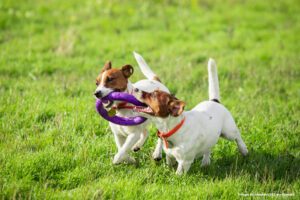Barks Blog
How to Break Up Dog Fights

by The Pet Professional Guild
From time to time, one may have to act quickly to prevent injury to either dogs or humans when one or more dogs get into a bad scuffle or an all-out fight. Unlike a training scenario in which we would reject the use of aversive methods, this is considered an emergency where safety and minimizing injury are the immediate concerns.
An Ounce of Prevention Is Worth a Pound of Cure
The first line of defense against the occurrence of fights is a good working knowledge of dog body language, especially stress signals. It’s important to remember that normal dog communication includes snarls, growls, and aggressive displays. Most of these signals are ritualistic and quickly self-limiting, as they are designed not to initiate fights but to avoid fights. Sometimes it’s fine to let dogs iron out their differences, as long as the interaction is quick, not prolonged, and fairly benign, and neither dog seems intent on escalating things. Chances are that you won’t even have time to make the decision whether or not to intervene, because such interactions often happen so fast that they are over before you can even get up from your chair.
Good prevention includes learning how to make dog-to-dog introductions as safe as possible. Avoid tension on leashes and having dogs meet on either dog’s home territory. Having anti-fight supplies handy so that you can get to them quickly is also important, even if you are expecting a positive outcome to the interaction.
It is also important for dog parks, play groups, group classes or other places where dogs congregate off leash to have a good screening process that eliminates most problem dogs from even entering the venue.
Questions to Ask When Screening
- Did your dog have experience playing off leash with a variety of other pups and dogs when he/she was between the ages of 8 and 16 weeks?
- If so, has your dog continued to play well with unfamiliar dogs?
- Has your dog ever bitten and punctured human or canine skin? (Puppy nipping before age 4-5 months doesn’t count.)
- What does your dog do if another dog wants his/her toy or to get close to you?
Good facility management means having a secure area where at least one dog can be segregated. This can be accomplished with firmly installed tether rings or a gated, permanently constructed holding pen (not an ex pen).
If a Fight Occurs
If a scuffle does occur and continues or escalates, and you fear that it will turn into an all-out fight, or it has already done so, there are some interventions you can try. If the dogs are not injuring one another, use the most benign method first. But if there is bloodshed, use what you must to get the dogs separated while preserving your own safety and that of other people.
The intention should always be to do as little harm as we can while ensuring safety and preventing injury. Also, remember that all dogs are different. Some of the strategies in your toolbox can escalate some dogs, rather than de-escalate them, so be prepared with a “plan B.”
First and foremost, try not to panic. It is common for people to scream at the dogs, and that can just intensify the tension and make things worse.
Possible First-Course Actions
- One rather ingenious strategy is to simply ring the doorbell if there is one. Some dogs are so conditioned by that noise that they disengage to see who has come to visit.
- Throw a blanket over the dogs. Some dogs will separate just from this. If they don’t, you at least have another small layer of protection from gnashing teeth if you must proceed to the next method.
- Spray the dogs with water. A hose can be very effective, but if there isn’t one handy, use a spray bottle (and keep one nearby at all times).
- Make a startling noise. Many dogs will disengage if you make some loud clatter. A metal shaker can with pennies in it can work (coffee cans work well if you duct tape the lid on after inserting the pennies), or clunk a couple of pans together. You can also use a small air horn from a marine supply store (cover your ears), or even a chair thumped on the floor. An added benefit of a chair is that you can also insert it between the dogs to help separate them without putting your hands in harm’s way.
More Extreme Actions
- Many dogs, such as Labradors and other water-loving breeds, are not deterred by water alone. In this case, you can use a spray bottle with water and lemon juice in it.
- The leg grab usually requires two people and should be discussed in advance. At the same time, each person grabs a dog by its hind legs at the point where the knee meets the stifle so each dog is in a “wheelbarrow” position. Then each person swings their dog to their right so the dogs’ mouths move away from one another. This makes it harder for the dogs to redirect a bite to the human behind them. Once the dogs are separated, move the dog closest to a door or other exit out of the room or area to prevent re-engagement. Note that this is a controversial method. It often works with smaller dogs, but could result in the people handling the dogs being severely injured if used on large, powerful dogs. You must carefully consider your and others’ safety before using any maneuver that involves physically engaging with dogs that are fighting. Redirected aggression is always a possibility, and you should never discount that some dogs are capable of seriously injuring you!
- A “break stick” is a tool that dog fighters use to pry one dog’s jaws off another dog. It is a very effective tool, but the possession of break sticks is illegal since they are used by those who purposely fight dogs. So, what is a legitimate force-free trainer to do? You can legally possess plastic tent stakes (from Home Depot) or nylon wood-splitting devices (Husky brand). These tools will provide you with a last-ditch means of prying one dog off another if nothing else works. To use a break stick, tether one dog then take control of the second dog and back away, so that both dogs are stretched out. Then wedge the stick into the gripping dog’s mouth and twist until the dog releases its grip.
Disclaimer:
Extreme measures such as lemon-water spray and break sticks are to be used ONLY IN THE EMERGENCY OF A SERIOUS DOG FIGHT. The Pet Professional Guild considers the use of these tools in normal training scenarios unnecessary and unacceptable.
